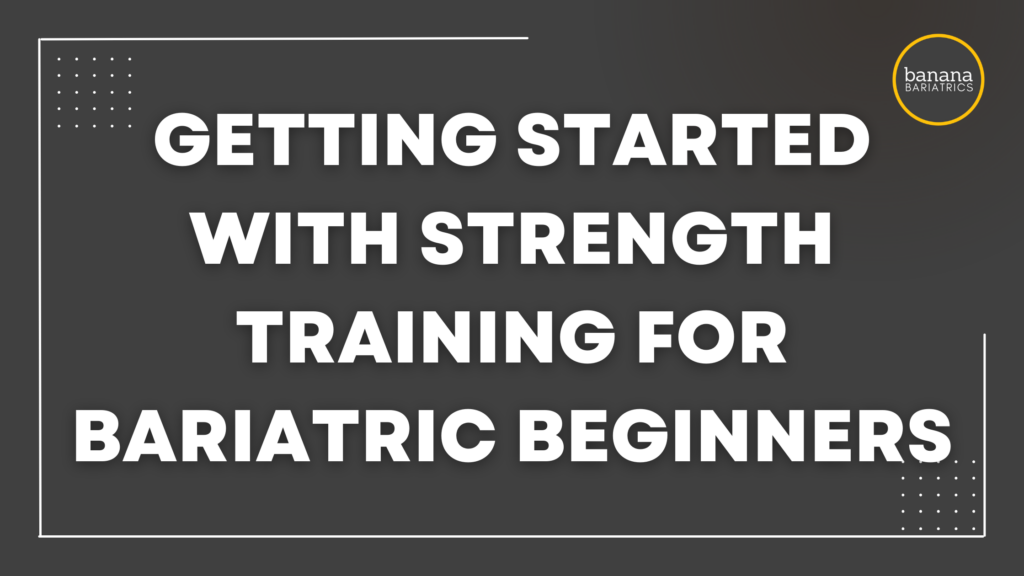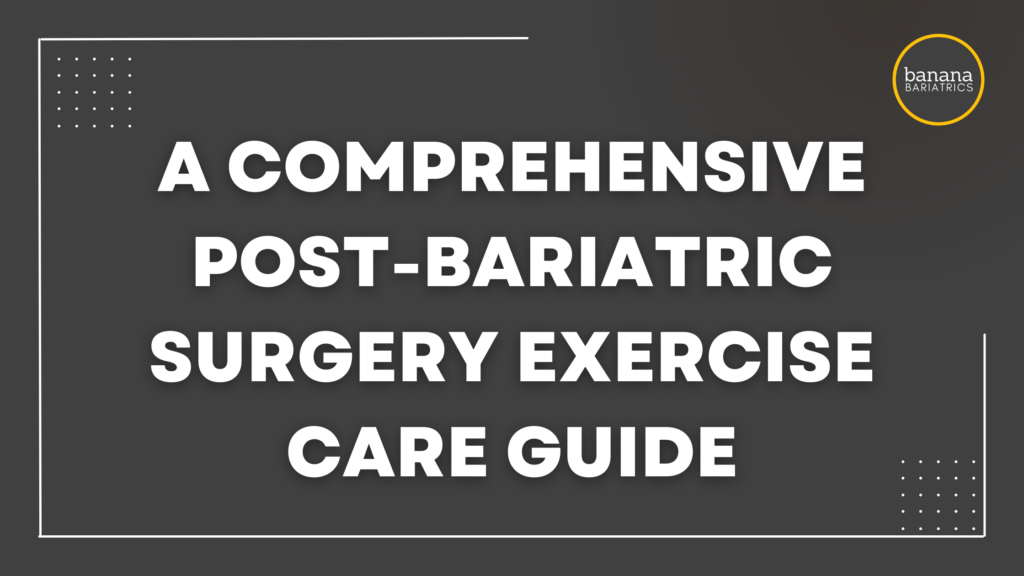Getting Started With Strength Training For Bariatric Beginners

Strength training can often summon pictures of bodybuilders and athletes, but it is actually a fundamental component of a balanced fitness routine for bariatric patients. Strength training involves using resistance to induce muscular contraction, which builds the strength, anaerobic endurance, and size of skeletal muscles. If you’re looking to get started with strength training, this blog post will walk you through how to get started with strength training, setting goals, creating a training plan, and ensuring you’re fully equipped with the knowledge to build a stronger and healthier body after weight loss surgery.
Understanding Strength Training
Strength training is more than lifting heavy weights. It’s about improving muscle strength and endurance through various types of resistance, such as free weights, weight machines, or your own body weight. Any physical activity that challenges your skeletal muscle mass counts as strength training. Understanding the principles behind strength training is crucial for effective and safe workouts.
Benefits of Strength Training
Strength training after bariatric surgery can significantly improve your recovery and overall health outcomes. Here are some of the key benefits:
- Improved Muscle Mass: Bariatric surgery often leads to significant weight loss, which can include loss of muscle mass. Strength training helps rebuild and preserve muscle tissue, improving overall body composition.
- Increased Metabolic Rate: Muscle tissue burns more calories than fat, even at rest. By increasing muscle mass through strength training, individuals can boost their metabolic rate, helping with more efficient weight management and fat loss.
- Enhanced Physical Function: As muscle strength and endurance improve, daily activities and mobility become easier. This can lead to a better quality of life and greater independence.
- Bone Health: Strength training is beneficial for bone density. After bariatric surgery, the risk of bone loss and osteoporosis can increase due to changes in hormones and nutrient absorption. Regular resistance training can help mitigate these risks by stimulating bone formation. This is especially true for women in menopause and/or patients who have had mal-absorptive procedures like bypass, SADI, and Switch.
- Improved Mental Health: Engaging in strength training has been shown to reduce symptoms of depression and anxiety. The physical activity can also boost self-esteem and body image, which are particularly important after the significant life change of bariatric surgery.
- Better Glycemic Control: Strength training can improve insulin sensitivity, which is crucial for managing or preventing type 2 diabetes—a common comorbidity of obesity.
- Reduced Risk of Surgery-Related Complications: Building a strong muscular foundation can help support the body’s recovery post-surgery, reducing the risk of complications such as hernias, which are more common in individuals with weaker abdominal muscles.
- Enhanced Heart Health: Regular strength training can improve cardiovascular health by lowering blood pressure, improving lipid profiles, and reducing the risk of heart disease.
Start With Low-Intensity Exercises
Incorporating strength training after bariatric surgery should be done under the guidance of a healthcare professional or a certified fitness trainer who specializes in post-bariatric surgery recovery. Starting slowly and focusing on proper technique can ensure safety and effectiveness during your training sessions. Here are some exercise exercises tailored for bariatric patients who are beginners at strength training, focusing on safety, gradual progression, and overall well-being:
1. Bodyweight Exercises
- Chair Squats: Start by sitting on a chair and standing up, using your legs’ strength. Repeat while ensuring proper form.
- Wall Push-ups: Face a wall, extend your arms, and push against the wall, keeping your feet planted. This is a gentler alternative to traditional push-ups.
- Seated Leg Lifts: Sit on a chair and extend one leg at a time in front of you. Hold the position for a few seconds, then lower the leg back down.
2. Resistance Band Exercises
- Band Pull Aparts: Hold a resistance band with both hands in front of you and pull the band apart while squeezing your shoulder blades together.
- Bicep Curls: Stand on the middle of a resistance band and hold an end in each hand. Curl your hands toward your shoulders, then slowly lower them back down.
- Leg Presses: Lie on your back, loop a band around your feet, and press your feet away from you, mimicking a leg press machine.
3. Light Free Weights
- Dumbbell Shoulder Press: Holding a light dumbbell in each hand, press the weights above your head and then lower them back to shoulder height.
- Bent-over Rows: Hold a dumbbell in each hand, bend slightly at the waist, and pull the dumbbells towards your waist, squeezing your shoulder blades.
- Wrist Curls: Support your forearm on a table, holding a light dumbbell, and curl your wrist up and down to strengthen your forearm muscles.
4. Stability Ball Exercises
- Ball Squats: Place a stability ball between your lower back and a wall. Slowly squat down, then rise back up, using the ball to maintain balance.
- Abdominal Crunches: Sit on a stability ball and perform abdominal crunches, focusing on using your core muscles to lift and lower your torso.
- Pelvic Tilts: Sit on a stability ball and gently tilt your pelvis forward and back, engaging your core and lower back muscles.
5. Aquatic Exercises
- Water Walking: Walk in chest-high water from one side of the pool to the other, facing resistance from the water.
- Aqua Aerobics: Join an aqua aerobics class, which often includes exercises like jumping jacks, leg kicks, and arm movements in the water.
Every workout session should start with a gentle warm-up to prepare your body, followed by a cool-down period to aid in recovery and prevent injuries. It’s essential to progress gradually, starting with lighter weights and fewer repetitions, and then slowly increasing the intensity as your strength and confidence grow. Listening to your body is crucial; any pain or discomfort beyond normal muscle fatigue should prompt you to stop the exercise immediately and seek professional advice. By adhering to these guidelines, you can safely navigate the journey of incorporating strength training into your post-surgery lifestyle, paving the way for improved recovery and long-term health benefits.
Overcoming Barriers That Prevent You From Getting Started
Overcoming barriers to getting started with any new habit, especially in the realm of starting a strength training routine requires planning and forethought. Whether these barriers are mental, physical, or situational, here are steps you can take to navigate through them and begin your journey toward your goals:
Identify Specific Barriers
The first step is to clearly identify what’s holding you back. Is it a lack of time, motivation, resources, or knowledge? Or perhaps fear of failure? Do you struggle with an “all-or-nothing” attitude? Pinpointing the exact nature of the barriers you face can help you address them more effectively. Changing your mindset to “progress over perfection” and being curious of why you may or may not have stayed consistent with your initial goals can help take away any self-blame and get you back into exercising again.
Set Clear, Achievable Goals
Setting vague goals is a common obstacle to getting started. Instead, set SMART goals—Specific, Measurable, Achievable, Relevant, and Time-bound. This clarity makes your objectives more tangible and manageable, which can significantly boost your motivation.
An example of a SMART goal could be: “I aim to start strength training with low-impact, bodyweight exercises three times a week for 20 minutes each session, to improve my muscle mass. I will review my progress after three months and adjust my training plan as needed.”
Start Small
One of the biggest mistakes is trying to take on too much, too soon. Break down your goals into smaller, manageable tasks. Celebrate small wins to keep yourself motivated. This gradual approach helps build confidence and momentum. If you haven’t started strength training since surgery, avoid the temptation to set high goals such as working out 5 days a week for an hour at a time. This will predispose you to an “all-or-nothing” headspace which can be destructive for continued progress. Instead, aim for 2-3 days and set a lower bar of time commitment to your exercise routine. The key is to start small, but to stay consistent.
Create a Plan
Having a plan acts as a roadmap to navigate your way to your goals. Schedule specific times for activities, prepare resources in advance, and outline steps to take. A plan transforms intention into action. Put the exact date and time into your calendar and/or phone so you commit to it like you would a doctor’s appointment.
Seek Support
A support network can provide encouragement, advice, and accountability. This could be friends, family, a mentor, or a positive and uplifting online bariatric community. Don’t underestimate the power of shared experiences and encouragement.
Leverage Resources and Tools
Utilize available resources and tools that can make starting easier. This could be educational materials, online courses, apps for tracking progress, or equipment that makes the activity more enjoyable. There are a lot of free YouTube channels on strength training for beginners.
Address Fear of Failure
Fear of failure is a significant barrier. Reframe failure as a learning opportunity rather than a setback. Each attempt provides valuable insights that bring you closer to your goals. If you need additional psychological support, reach out to a bariatric psychologist for help on your journey.
Focus on the Benefits
Keep the benefits of achieving your goal at the forefront of your mind. Whether it’s improved health, personal growth, or the satisfaction of accomplishing something, focusing on the positive outcomes can provide a strong motivation to start. Most importantly, revisit your “Why.” Why did you have surgery in the first place? The further out you are from surgery, the more you should change and refine your “Why.” Your “Why” will adapt as time goes on as you set newer (and higher) goals for yourself.
Adjust Your Environment
Make your environment conducive to starting. This could mean setting up a dedicated workspace, removing distractions, or surrounding yourself with visual reminders of your goals. Clear out your garage or a room in the basement, purchase your yoga mat and exercise equipment, ensure you have comfortable shoes and clothes, and make your space enjoyable to be in prior to starting your strength training routine.
Practice Self-Compassion
Be kind to yourself. Progress is rarely linear, and setbacks are part of the journey. Practice self-compassion and recognize the effort you’re putting in, regardless of the pace of progress.
Reward Yourself
Give yourself non-food related incentives like new workout gear, spa treatments, or hobby supplies for sticking with your exercise routine. Investing in fitness gadgets, enjoying books, or planning a mini-vacation can serve as exciting milestones. Rewards can motivate you to take the initial steps and continue moving forward.
In Conclusion
Strength training serves as a pivotal component of a balanced fitness routine for all bariatric patients aiming for a healthier post-operative life. The myriad of benefits that strength training has includes enhanced muscle mass, improved metabolic rate, and better overall physical function. When starting a routine, begin with low-intensity exercises. Anticipate barriers and develop a strategic mindful approach to keep you motivated and consistent on your strength training journey.
Need Extra Help With Starting An Exercise Routine?
Our FREE Bariatric Fitness Guide will help you:
- Set realistic goals that are attainable, flexible, and will help keep you motivated
- Gain insights on your overall body composition than just a number on the scale
- Learn about different low-impact exercises that are joint-friendly and pain-free
- Fuel your workouts with pre and post-workout food options
- Build and progress your fitness abilities through tracking and community support







Responses